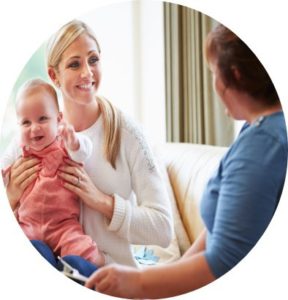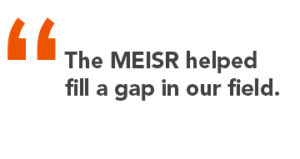MEISR User Q&A with Cami Stevenson
Daily family life is a vital training ground where young children participate in routines that nurture their social-emotional, language, and cognitive skills. There’s now a new tool to reliably assess this crucial aspect of child development—the MEISR™.
The Measure of Engagement, Independence, and Social Relationships (MEISR™) analyzes functional behaviors of children up to age 3 within the context of 14 typical family routines.
Designed to fit seamlessly into a family’s regular schedule, the MEISR can be completed in only 45 minutes by a parent or caregiver, either on their own or under the supervision of an early interventionist. The MEISR is an ideal starting point for families and intervention teams to discuss how to best support a child’s engagement in daily activities—an important prerequisite for learning. The results can be used to:
- Empower families to enhance natural learning opportunities
- Help families choose functional skills to address within the Individualized Family Service Plan (IFSP)
- Help your team determine Child Outcome Summary (COS) ratings
- Develop individualized intervention priorities
- Do you frequently remind the child of expectations in a supportive, non-disciplinary way?
To add a valuable real-world perspective, we recently spoke with Cami Stevenson, EI/ECSE Asst. Administrator for Multnomah Early Childhood Program (MCEP) in Portland, Oregon. Cami is a supervisor and leader of a larger team of service providers that have been using the MEISR for the past year. Here’s what she had to say about her professional experiences with the MEISR.
1. How long have you been using the MEISR, and what factored into your decision to start using it?

The MEISR has been part of my professional life for many years now. When I was in direct service to children and families several years ago, I used it because it was such a nice tool to show task analysis breakdown of functional skills for a certain routine. It was great to share and use the MEISR with families because it helped us focus on the functional skills needed to improve a child’s daily routines.
At MECP, we started using the tool at the beginning of the 2018 school year. We decided to use the MEISR because we noticed we didn’t have a reliable way to track children’s functional behaviors and measure their progress over time. The MEISR fits this bill.
2. In the time that you’ve been using the tool, what have been the biggest benefits to your program?
As an administrator for the MECP program, I think the MEISR is a great tool for families and professionals. Here are some of the benefits I’ve observed:
-
- The MEISR is a simple and helpful starting point for talking about a child’s functioning within everyday routines.
-
- Using the MEISR helps paint the picture that intervention can occur in families’ busy daily lives naturally, through already-established learning opportunities.
-
- As the title of the tool says, the MEISR helps both parents and providers think about the engagement, independence, and social relationships of a child. It’s important that the MEISR highlights and emphasizes child engagement, such a critical part of child development and growth.
-
- The MEISR helps providers by creating a functional snapshot of children on their caseloads. It highlights children’s strengths and needs within routines and aids both families and providers in identifying priorities for IFSPs.
-
- During home visits, the MEISR helps build valuable conversations around daily routines that are naturally occurring, a more effective approach than clinic-style home visits where the provider works on skill development for just 30 minutes. With the MEISR, I have seen a shift within my service providers—now, they talk more about functional skills within the context of routines, not just skills development in isolation.
At MECP, evaluation is followed by needs assessment with the Routines-Based Interview. The MEISR is also used on our routines-based home visits, and we’ve found it to be a great stepping-stone to help focus the visit on function participation and behaviors.
3. What was the most significant challenge when your program first started using the MEISR, and how did you address it?

The people who know the child best—the parents or caregivers—fill out the MEISR. Some parents have commented that it is a long document and takes a long time to fill out. Other families are not able to complete the MEISR individually, because of a language barrier, for example. In a case like this, our service providers will take a routine at a time and support parents in completing the MEISR during a home visit. This can be a challenge because it does take away from home visit time, but we’ve found that giving families the support they need to fill out the MEISR is well worth the time. Helping families with the MEISR is a good way to develop the provider–family relationship and share ideas on what skills to address first.
4. Can you briefly walk us through your process for conducting an assessment with the MEISR?

At MECP, we give the MEISR to families after a child’s early intervention eligibility is determined. The MEISR is given as an important “next step” after the evaluation. We ask parents to fill it out before the next meeting, which is called the Routines-Based Interview (RBI). This process helps us meet two objectives. First, for parents who are anxious to get started and want to know what’s going to happen next, filling out the MEISR gives them something concrete to do. Second, having them fill out a tool based on the functional behaviors of a routine gets parents thinking about the things they’ll need to focus on during the Routines-Based Interview, a needs assessment that helps families decide on outcomes and goals. (Learn more about RBI.)
5. In your experience, how does the MEISR complement the other tools and interventions you’re using?

In Oregon, our state assessment is the Assessment, Evaluation, and Programming System for Infants and Young Children (AEPS®). We’ve found that the MEISR is a great complement to this tool. AEPS assesses a child’s skills in developmental domains (fine motor, gross motor, cognitive, adaptive, social-communication, and social). The MEISR then takes many of those skills and shows which specific routines they are needed in, which helps families and providers know what to focus on in order to increase participation in those routines. As indicated above, the MEISR is also an excellent complement to routines-based intervention or routines-based home visits.
6. What would you say to a program reluctant to adopt the MEISR become of time constraints and logistics?
I’d say that because parents fill out the MEISR, it isn’t generally much of a time constraint on programs. And I’d tell them about the success we’ve had. A year ago, we started implementing the MEISR program-wide, and the MECP now serves roughly thr ee thousand children and families birth to five years old. We have had a high return rate of families filling them out, so as a program we believe this is increasing our family engagement.
ee thousand children and families birth to five years old. We have had a high return rate of families filling them out, so as a program we believe this is increasing our family engagement.
Roadblocks can be overcome with a little creativity. For example, at MECP we have three outside agencies that do our evaluations to determine if a child is eligible for early intervention or early childhood special education. We find that after the evaluation but before the Routines-Based Interview is the best time to have a caregiver complete the MEISR, but we were having trouble figuring out how to get the MEISR to the parent after the evaluation but before the meeting in a timely manner while still meeting the 30-day timeline. We were able to partner with the evaluation teams to have them give the MEISR to families who qualified as a “next step” to prepare for their Individual Family Service Plan meeting. This solved a few problems for us. First, it solved the problem of getting it into the families’ hands. Second, it was a tangible to-do item for parents anxious to get started with early intervention. A surprise benefit was that it also strengthened our relationship with our evaluation teams as they saw the benefit of the tool—a win for all!
The MEISR helped fill a gap in our field, and we’ve been successful in our initial implementation of using the tool for children and families under 3 years old. If we can problem-solve our logistics and roadblocks, any program can be successful.
To learn more, take an illustrated tour of the MEISR assessment process or check out MEISR at-a-glance.
Register for the Webinar!
Using the Measure of Engagement, Independence, and Social Relationships (MEISR™)
When: Wed, Oct 23, 2019 2:00 PM – 3:00 PM EDT
You’re invited to join MEISR developers R.A. McWilliam, Ph.D., and Naomi O. Younggren, Ph.D., for a free introductory webinar on Oct. 23rd. You’ll get expert insight into topics like the relationship between the MEISR and the Routines-Based Interview (RBI) and how MEISR results can be used to further early intervention efforts. Live Q&A to follow!


